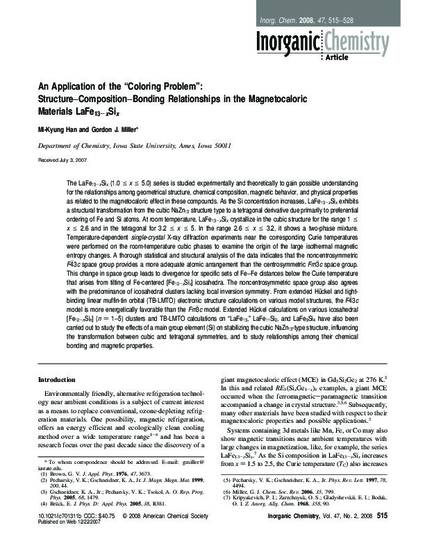
The LaFe13-xSix (1.0 ≤ x ≤ 5.0) series is studied experimentally and theoretically to gain possible understanding for the relationships among geometrical structure, chemical composition, magnetic behavior, and physical properties as related to the magnetocaloric effect in these compounds. As the Si concentration increases, LaFe13-xSix exhibits a structural transformation from the cubic NaZn13 structure type to a tetragonal derivative due primarily to preferential ordering of Fe and Si atoms. At room temperature, LaFe13-xSix crystallize in the cubic structure for the range 1 ≤ x ≤ 2.6 and in the tetragonal for 3.2 ≤ x ≤ 5. In the range 2.6 ≤ x ≤ 3.2, it shows a two-phase mixture. Temperature-dependent single-crystal X-ray diffraction experiments near the corresponding Curie temperatures were performed on the room-temperature cubic phases to examine the origin of the large isothermal magnetic entropy changes. A thorough statistical and structural analysis of the data indicates that the noncentrosymmetric F4̄3c space group provides a more adequate atomic arrangement than the centrosymmetric Fm3̄c space group. This change in space group leads to divergence for specific sets of Fe−Fe distances below the Curie temperature that arises from tilting of Fe-centered [Fe12-xSix] icosahedra. The noncentrosymmetric space group also agrees with the predominance of icosahedral clusters lacking local inversion symmetry. From extended Hückel and tight-binding linear muffin-tin orbital (TB-LMTO) electronic structure calculations on various model structures, the F4̄3c model is more energetically favorable than the Fm3̄c model. Extended Hückel calculations on various icosahedral [Fe12-nSin] (n = 1−5) clusters and TB-LMTO calculations on “LaFe13,” LaFe11Si2, and LaFe9Si4 have also been carried out to study the effects of a main group element (Si) on stabilizing the cubic NaZn13-type structure, influencing the transformation between cubic and tetragonal symmetries, and to study relationships among their chemical bonding and magnetic properties.
Available at: http://works.bepress.com/gordon-miller/16/

Reprinted (adapted) with permission from Inorg. Chem., 2008, 47 (2), pp 515–528. Copyright 2008 American Chemical Society.